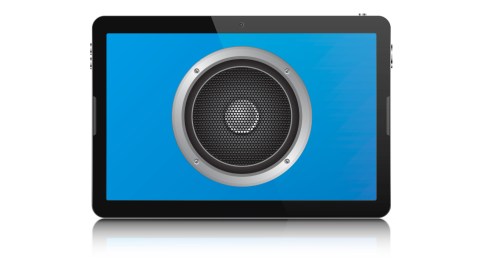Google’s latest acquisition? Sound without speakers

Image source: haali/RealVector/Shutterstock/Big Think
Bloomberg revealed last week that at some time before December 13, 2017, Google purchased a U.K.-based startup called Redux. It’s not clear exactly when the purchase occurred. Redux had patented a way to produce high-quality audio using a display as the speaker, eliminating the need for, you know, speakers. Given the premium placed on slender, lightweight mobile technology, the removal of speakers could free up space inside Google devices for other parts or more expansive batteries. It could be that this the future of audio on mobile devices.
We’re all used to sound coming to us through flexible membranes, whether they’re speakers or little earbuds. In these devices, skin-like woofers and tweeters are electrically pushed out, and then snap back in, to deliver compression waves that push air molecules against our eardrums, and that we interpret as sound.
The system Google has just purchased uses bending waves, an object of fascination in recent years to audio manufacturers and scientists. Systems that pair bending waves with rigid vibrating elements do more than just save space in thin device like phones, tablets, or flat-panel TVs and computers: They hold the promise of more accurate sound reproduction than can be achieved with conventional technology, since unwanted timbral coloration is easier to eliminate in a rigid surface.
So, what’s a bending wave? Bending-wave loudspeaker manufacturer Göbel offers a way to imagine how a bending wave propagates:
Just imagine you are throwing a stone into a lake! The water surface is being destabilised by this impulse. This shows, as we can witness a wave that propagates equally to each side.
In a 2002 thesis, Masters candidate M.C. Brink explains how a piano produces its sound via bending waves, noting that, “By pressing a key on the piano, vibrations will be introduced at certain positions on the plates and the bending waves that appear spread out, just like other waves, over the medium.”
Bending waves also count for how you can hear someone in another room without being able to see them: Sound waves bend around corners while light waves don’t.
A bending-wave speaker such as those envisioned by Redux begin with a proprietary actuator beneath the display that introduces a bending wave into some point on the back of the display, where its vibrations ripple outward across the surface, and eventually out in the air and into our ears.
Each sound we hear is a stack of waves at different pitches, or frequencies, sounding at the same time to collectively produce the harmonic overtones that give each timbre its unique sound. And so, a bending-wave system contains multiple actuators, each of produces a particular range of frequencies. To reproduce rich sound, multiple actuators fire off behind the display.
Our visual image, then changes from a single pebble to a lovely vision of raindrops on a pond producing concentric patterns that intersect and overlap across the surface.
What Google has purchased involves a bit more than audio, though, contrary to much of the press coverage. Redux was also deep into research on haptics, technology that uses vibrations to make it feel as if you’re physically interacting with a virtual object, such as an onscreen button, or a representation of a dial. Redux used bending waves to produce haptic effects as well.
The idea of haptics is to reinforce feedback, the principle of interface design that stresses the importance of elements that confirm for the user that an action has been successfully executed. When it’s used to simulate the experience of operating real-world controls, the appeal of haptics is largely skeuomorphic, meaning the virtual version of a control is meant to seem like its traditional model in order to make the user feel at home with new technology. There’s some debate over whether skeuomorphism is a smart idea or not at this point, since most users now are more familiar with virtual tech than with old-school physical hardware.
Redux demoed its technology last February.
It’s anybody’s guess if Google is interested in speakerless audio or haptic feedback, and it could be argued that Redux’s audio represents a step into the future and haptics a skeuomorphic step into the past. Either way, we’re curious to see what becomes of this intriguing acquisition.





